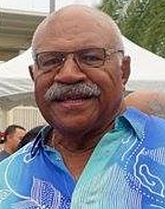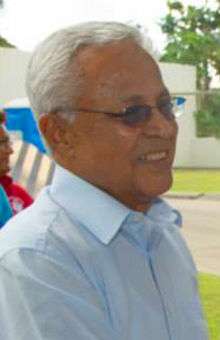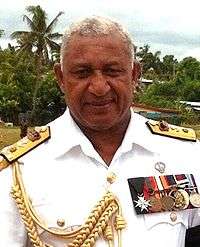Prime Minister of Fiji
The Prime Minister of the Republic of Fiji is the head of government of Fiji. The Prime Minister is appointed by the President under the terms of the 2013 Constitution of Fiji.
| Prime Minister of the Republic of Fiji | |
|---|---|
 Coat of arms of the Republic of Fiji | |
| Style | The Right Honourable |
| Seat | Government Buildings, Suva |
| Appointer | President of Fiji |
| Inaugural holder | Kamisese Mara |
| Formation | 10 October 1970 |
| Salary | FJ$ 328,750 annually[1] |
| Website | http://www.pmoffice.gov.fj/ |
 |
|---|
| This article is part of a series on the politics and government of Fiji |
|
Legislative
|
|
Judiciary
|
|
Description of the office
As a former British colony, Fiji has largely adopted British political models and follows the Westminster, or Cabinet, system of government, in which the executive branch of government is responsible to the legislature. The Prime Minister is appointed by the President, but must be supported, or at least accepted, by a majority in the House of Representatives. If at any time the Prime Minister loses the "confidence" of the House, he must resign, along with the entire Cabinet. In practice, this usually reduces the Prime Minister's appointment to a formality, as the parliamentary leader of the majority political party or coalition is invariably appointed. If, however, no such majority party or coalition exists, whether due to electoral fragmentation or to party realignments after an election, the President's role becomes much more important. The President must endeavour to find a candidate acceptable to a majority in the House; if no such candidate can be found, the President must dissolve Parliament and call an election prematurely.
The Prime Minister of Fiji is technically the "first among equals," whose vote in meetings of the Cabinet carries no greater weight than that of any other minister. In practice, the Prime Minister dominates the government. Other Ministers are appointed by the President, but on the Prime Minister's advice, and may be dismissed by him at any time (although his control over ministerial appointments may be tempered by the realities of coalition politics: the leader or leaders of coalition partners may insist on having a say in the matter too).
History of the office
Ratu Sir Kamisese Mara was appointed Fiji's first Prime Minister on 10 October 1970, when Fiji attained its independence from Britain. Mara previously served as Fiji's first an only Chief Minister, from 20 September 1967 (while Fiji still was a British colony). Mara's first term as Prime Minister lasted until 13 April 1987. He returned to the office for the second term on 5 December 1987, serving until 2 June 1992. As of 2014, Mara is the longest-serving Prime Minister of Fiji.
List of Prime Ministers of Fiji (1970–present)
| No. | Portrait | Prime Minister | Took office | Left office | Time in office | Party | Election | Head of State |
|---|---|---|---|---|---|---|---|---|
| Prime Ministers of the Dominion of Fiji | ||||||||
| 1 | Ratu Sir Kamisese Mara (1920–2004) | 10 October 1970 | 13 April 1987 | 16 years, 185 days | Alliance | 1972 1977 (Mar) 1977 (Sep) 1982 | Elizabeth II | |
| 2 | Timoci Bavadra (1934–1989) | 13 April 1987 | 14 May 1987 | 31 days | Labour | 1987 | Elizabeth II | |
| Vacant (14 May 1987 – 5 December 1987)[lower-alpha 1] | ||||||||
| Prime Ministers of the Republic of Fiji | ||||||||
| (1) | Ratu Sir Kamisese Mara (1920–2004) [lower-alpha 2] | 5 December 1987 | 2 June 1992 | 4 years, 180 days | Independent | — | Penaia Ganilau | |
| 3 | Major general (Rtd) Sitiveni Rabuka (born 1948) | 2 June 1992 | 19 May 1999 | 6 years, 351 days | SVT | 1992 1994 | Penaia Ganilau Kamisese Mara | |
| 4 | Mahendra Chaudhry (born 1942) | 19 May 1999 | 27 May 2000 | 1 year, 8 days | Labour | 1999 | Kamisese Mara | |
| 5 | Ratu Tevita Momoedonu (born 1941) [lower-alpha 3] | 27 May 2000 | 27 May 2000 | 0 days | Labour | — | Kamisese Mara | |
| Vacant (27 May 2000 – 4 July 2000)[lower-alpha 1] | ||||||||
| 6 | Laisenia Qarase (1941–2020) [lower-alpha 4] | 4 July 2000 | 14 March 2001 | 253 days | Independent | — | Frank Bainimarama Josefa Iloilo | |
| – | Ratu Tevita Momoedonu (born 1941) Acting | 14 March 2001 | 16 March 2001 | 2 days | Labour | — | Josefa Iloilo | |
| (6) | Laisenia Qarase (1941–2020) | 16 March 2001 | 5 December 2006 | 5 years, 264 days | SDL | 2001 2006 | Josefa Iloilo | |
| – | Dr. Jona Senilagakali (1929–2011) Acting [lower-alpha 5] | 5 December 2006 | 4 January 2007 | 30 days | Independent | — | Frank Bainimarama | |
| – | Commodore Frank Bainimarama (born 1954) Acting [lower-alpha 6] | 5 January 2007 | 22 September 2014 | 7 years, 260 days | RFMF | — | Josefa Iloilo Epeli Nailatikau | |
| 8 | Commodore (Rtd) Frank Bainimarama (born 1954) | 22 September 2014 | Incumbent | 5 years, 320 days | FijiFirst | 2014 2018 | Epeli Nailatikau Jioji Konrote | |
Notes
- Two military coups in 1987 and a civilian coup d'état in 2000 left Fiji without a Prime Minister each time.
- Mara's party, the Alliance Party, was dissolved in the wake of the 1987 coups, so he was effectively a non-partisan Prime Minister in his last term.
- Ratu Momoedonu was appointed Prime Minister on 27 May 2000, by the then-President, Ratu Sir Kamisese Mara, in order to meet a constitutional technicality. He resigned only a few minutes later, as soon as the technicality had been attended to, in order to allow the President to assume full executive power.
- Qarase was not a member of a political party when he headed the interim government in 2000 and early 2001. Following his reinstatement on 16 March 2001 (after two days' absence from office), he founded the United Fiji Party to contest the general election that was to be held later that year.
- Senilagakali was installed as Interim Prime Minister as Commodore Josaia Voreqe (Frank) Bainimarama took control of the Government. He was previously a highly esteemed medical doctor, the former President of the Fijian Medical Association, and was military doctor at the time of the coup d'état in 2006.[2]
- The Bainimarama government was dismissed as illegal by Fiji's Court of Appeal on 10 April 2009, leading to the Prime Minister's immediate resignation. He was re-appointed the next day by President Josefa Iloilo, following the latter's abrogation of the Constitution.[3][4]
References
- Government of Fiji Gazette (3 October 2014). "PARLIAMENTARY REMUNERATIONS DECREE 2014 (DECREE NO. 29 OF 2014)" (PDF). www.parliament.gov.fj.
- "Military now in charge in Fiji". Fiji Times. 5 December 2006. Archived from the original on 30 September 2007. Retrieved 5 December 2006.
- "Fiji's Bainimarama steps down as PM", Australian Broadcasting Corporation, 10 April 2009
- "Commodore Bainimarama sworn in as Prime Minister" Archived 15 April 2009 at the Wayback Machine, Fiji government, 11 April 2009





.jpg)
